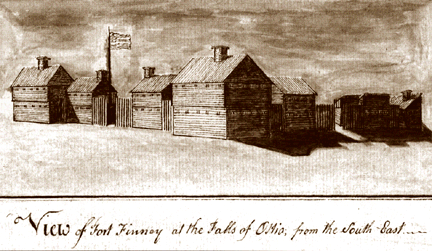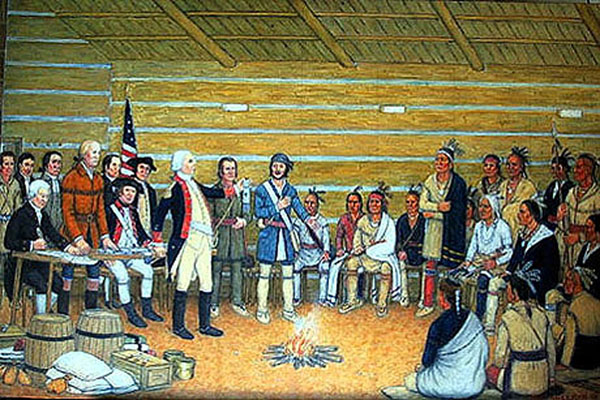 |
 |
|
Photographs (left to right): Wakulla Springs, Florida; Alligator, Florida; Sap Sucker Bark, Florida
The Wampum Belt Archive
Wampum Belts in Paintings and other Art Media
Fort Finney Treaty 1786


Colonel Richard Butler, George Rogers Clark are holding a Treaty in 1786 at Fort Finney with the Shawnee and Wyandots at the mouth of the Great Miami River. Artist: Hal Sherman.

The war chief then flung upon the table a black and white wampum (belt) to signify peace or war, the choice to be made by the commissioners.
(Hypothetical Reproduction 1- Richard D Hamell Feb 21 2020

(Hypothetical Reproduction 2- Richard D Hamell Feb 21 2020
Original Size: |
? |
Reproduction: |
Length: 32 inches. Width: 7.55 inches. 54 inches with fringe |
Beads: |
192 columns. Rows 15. 2,280 beads |
Materials: |
Warp: Deer leather. Weft. Artificial Sinew. Polymer Beads |
Description:
Ohio History Encyclopedia noted:
"In 1785, the Confederation Congress dispatched Richard Butler and Samuel Holden Parsons to negotiate a treaty with the Shawnee Indians. The Shawnees refused to accept the terms of the Treaty of Fort McIntosh, and the American government hoped that war could be avoided with the Indians. The negotiations took place at Fort Finney, near modern day Cincinnati, Ohio. The Shawnees refused to accept the land set aside for them in the Treaty of Fort McIntosh. They gave the American negotiators a belt of black wampum, a sign of war. Butler and Parsons threatened the Shawnees with attack if they refused to the Americans' demands. Shawnee leaders, fearing the power of the American military, agreed to the Treaty of Fort Finney, also known as the Treaty at the Mouth of the Great Miami, on January 31, 1786. The Shawnee leaders in attendance agreed to relinquish all claims to their land in southwestern Ohio and southern Indiana. They promised to move to the land set aside for them in the Treaty of Fort McIntosh. The Americans also promised to keep white squatters from settling on land reserved exclusively for the Indians.
Although some of the Shawnee Indians signed the treaty, many of them refused to abide by it. Most still claimed all of the land north of the Ohio River. White settlers now viewed that land as theirs and began to move into the region. Violence continued between the Americans and Indians in the Ohio Country."
Fort Finney (http://www.whitewaterriverfoundation.org/PointsofInterest/fortfinney.html)
On January 14, 1786, there were 450 Indiana present, which greatly outnumbered the U.S. troops. About 130 were Delaware and Wyandot, with women and children among them. For entertainment, dancing was held in the council house outside of the fort. The war dance was performed in breechcloth and their faces and bodies were painted. Tomahawks and scalping knives were present, which caused the commissioners and soldiers to sense danger. The commissioners had their soldiers cook and serve food to the Indians in the council house. As the Shawnees always selected old and decrepit women to do the cooking, when they saw the U.S. soldiers serving food, they laughed and shouted at them in derision, crying out, "Here come the old women with warrior coats on"! an Indian's most insulting contempt was to call someone an "old woman". Then on January 31st, three hundred face-painted Indian warriors filed into the council house. Their demeanor was sullen and suspicious. a warrior of the Delaware named Bohengehelus addressed General Clark. "I assigned the hatchet into the hands of my kings. I have ceased to war and have come to council fire to promote peace..." another Delaware chief, Texapxie, advised the Shawnee to follow his example, to lay down the hatchet and nevermore take it up. The first article of the treaty required that three Indian hostages be held until all the U.S. prisoners, white and black, taken in the war with the Shawnee Nation, were restored. This demand angered the Shawnee. The Shawnee's old council sachem (the supreme chief), named Molunthy, and the war chief, Kehenepelathy, took the lead. The war chief made a boisterous and threatening speech, which caused his warriors to whoop at every pause. His speech briefly stated that it was not their custom to give hostages and that God had given them the land and they did not understand why they were expected to measure it out. He stated that they wanted no part in trading land for goods. The war chief then flung upon the table a black and white wampum (belt) to signify peace or war, the choice to be made by the commissioners. General Clark pushed the sacred wampum off the table with his cane. Every Indian started from his seat and gave out peculiar savage sounds. Clark then rose, stamped his foot on it, then ordered them to leave. They did so and all night debating was heard in the bushes near the fort while the troops held their guns ready. The war chief was for war, but the old Shawnee sachem, Molunthy, was for peace. The latter prevailed and the next morning he presented a white string, canceling out what the chief warrior had said, and prayed that they would have pity on the women and children. After the treaty was signed on February 1st, five Shawnees were left as hostages. This was the first surrender of territory by Indians west of the Alleghenies. It was the first acknowledgement by any sovereignty of the United states. By the treaty at Fort Finney, the United States was acknowledged to be the sole and absolute sovereign of all the territory ceded to them by the treaty with Great Britain in 1784. The Shawnee were to leave southern Ohio and their hunting grounds would become Indiana. Beyond which lines none of the citizens of the United states shall settle, nor disturb the Shawnees in their settlement possession. This laid the foundation for settling the Northwest Territory, which had begun to be surveyed in this area in 1798. The treaty failed entirely in securing peace, as the tribes more distant west than the Shawnee were in no way disposed to cease their incursions. The troops remained at Fort Finney for several months. St. Patrick's Day was celebrated by getting drunk and by evening only six men were fit for duty. The next day one man died from the effects of alcohol. Lt. Denny's diary at the fort ends in July 1786, when he was ordered to Fort Harmar. It is unknown when Fort Finney was abandoned but it was before the settlement of North Bend, Ohio, by Judge John Cleves Symmes in 1789. Note: General George Rogers Clark was a hero of the American Revolution. His brother was William Clark, who in 1804 accompanied by Meriwether Lewis in an exploration of the western states. Source: "History of Dearborn County and Ohio Counties, Indiana", written in 1885 and also "The Mouth of the Great Miami", by Marjorie Burress.
Reference:
http://www.shawnee-bluejacket.com/Gallery.htm
Ohio History Encyclopedia. 2012. http://www.ohiohistorycentral.org/entry.php?rec=1425
 |
 |
 |
 |
 |
 |
 |
 |
|---|
